Samsung SNB-2000-N User Manual

SNB-2000(P)
Network Camera
User Manual
imagine the possibilities
Thanks you for purchasing this Samsung product. To receive a more complete service, please visit our website
www.samsungsecurity.com
RoHS compliant
Our product complies with “The Restriction Of the use of certain Hazardous Substances in electrical and electronic equipment”, and we do not use the 6 hazardous materialsCadmium (Cd), Lead (Pb), Mercury (Hg), Hexavalent
Chromium (Cr+6), Poly Brominated Biphenyls (PBBs), Poly Brominated Diphenyl Ethers (PBDEs)- in our products.
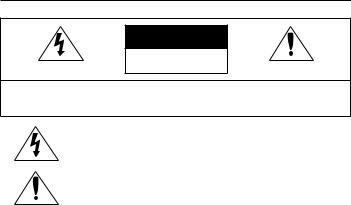
overview
CAUTION
RISK OF ELECTRIC SHOCK.
DO NOT OPEN
CAUTION: TO REDUCE THE RISK OF ELECTRIC SHOCK, DO NOT REMOVE COVER (OR BACK) NO USER SERVICEABLE PARTS INSIDE. REFER SERVICING TO QUALIFIED SERVICE PERSONNEL.
This symbol indicates that dangerous voltage consisting a risk of electric shock is present within this unit.
This symbol indicates that there are important operating and maintenance instructions in the literature accompanying this unit.
WARNING
To reduce the risk of fire or electric shock, do not expose this appliance to rain or moisture.
To prevent injury, this apparatus must be securely attached to the floor/ wall in accordance with the installation instructions.
If this power supply is used at 24V ac, a suitable plug adapter should be used.
The camera is to be only connected to PoE networks without routing to the outside plant.
WARNING
1.Be sure to use only the standard adapter that is specified in the specification sheet.
Using any other adapter could cause fire, electrical shock, or damage to the product.
2.Incorrectly connecting the power supply or replacing battery may cause explosion, fire, electric shock, or damage to the product.
3.Do not connect multiple cameras to a single adapter. Exceeding the capacity may cause abnormal heat generation or fire.
4.Securely plug the power cord into the power receptacle. Insecure connection may cause fire.
_ overview

5. |
When installing the camera, fasten it securely and firmly. The fall of |
|
|
|
camera may cause personal injury. |
|
|
6. |
Do not place conductive objects (e.g. screwdrivers, coins, metal parts, |
|
|
|
etc.) or containers filled with water on top of the camera. Doing so may |
|
|
|
cause personal injury due to fire, electric shock, or falling objects. |
|
|
7. |
Do not install the unit in humid, dusty, or sooty locations. Doing so may |
|
|
|
cause fire or electric shock. |
r |
|
|
|
|
|
|
|
● |
|
8. |
If any unusual smells or smoke come from the unit, stop using the |
eiwove |
|
|
|||
|
product. In such case, immediately disconnect the power source and |
|
|
|
v |
|
|
|
contact the service center. Continued use in such a condition may |
|
|
|
cause fire or electric shock. |
|
|
9. |
If this product fails to operate normally, contact the nearest service |
|
|
|
center. Never disassemble or modify this product in any way. (SAMSUNG |
|
|
|
is not liable for problems caused by unauthorized modifications or |
|
|
|
attempted repair.) |
|
|
10. |
When cleaning, do not spray water directly onto parts of the product. |
|
|
|
Doing so may cause fire or electric shock |
|
|
11. |
Do not expose the product to the direct airflow from an air conditioner. |
|
|
|
Otherwise, it may cause moisture condensation inside the Clear Dome |
|
|
|
due to temperature difference between internal and external of the |
|
|
|
dome camera. |
|
|
12. |
If you install this product in a low-temp area such as inside a cold store, |
|
|
|
you must seal up the wiring pipe with silicon, so that the external air can |
|
|
|
not flow inside the housing. |
|
|
|
Otherwise, external high, humid air may flow inside the housing, pooling |
|
|
|
moisture or vapor inside the product due to a difference between |
|
|
|
internal and external temperature. |
|
|
English _

overview
CAUTION
1.Do not drop objects on the product or apply strong blows to it. Keep away from a location subject to excessive vibration or magnetic interference.
2.Do not install in a location subject to high temperature (over 50°C), low temperature (below -10°C), or high humidity. Doing so may cause fire or electric shock.
3.If you want to relocate the already installed product, be sure to turn off the power and then move or reinstall it.
4.Remove the power plug from the outlet when there is a lighting storm. Neglecting to do so may cause fire or damage to the product.
5.Keep out of direct sunlight and heat radiation sources. It may cause fire.
6.Install it in a place with good ventilation.
7.Avoid aiming the camera directly towards extremely bright objects such as sun, as this may damage the CCD image sensor.
8.Apparatus shall not be exposed to dripping or splashing and no objects filled with liquids, such as vases, shall be placed on the apparatus.
9.The Mains plug is used as a disconnect device and shall stay readily operable at any time.
10.When using the camera outdoors, moisture may occur inside the camera due to temperature difference between indoors and outdoors. For this reason, it is recommended to install the camera indoors. For outdoor use, use the camera with built-in fan and heater.
_ overview

FCC Statement
This device complies with part 15 of the FCC Rules. Operation is subject to the following two conditions :
1)This device may not cause harmful interference, and
2)This device must accept any interference received including interference that may cause undesired operation.
CAUTION
This equipment has been tested and found to comply with the limits for a Class A digital device, pursuant to part 15 of FCC Rules. These limits are designed to provide reasonable protection against harmful interference when the equipment is operated in a commercial environment.
This equipment generates, uses, and can radiate radio frequency energy and, if not installed and used in accordance with the instruction manual, may cause harmful interference to radio communications. Operation of this equipment in a residential area is likely to cause harmful interference in which case the user will be required to correct the interference at his own expense.
IC Compliance Notice
This Class A digital apparatus meets all requirements of the Canadian Interference.-Causing Equipment Regulations of ICES-003.
v eiwove ●r
English _

overview
important safety instructions
1.Read these instructions.
2.Keep these instructions.
3.Heed all warnings.
4.Follow all instructions.
5.Do not use this apparatus near water.
6.Clean only with dry cloth.
7.Do not block any ventilation openings. Install in accordance with the manufacturer’s instructions.
8.Do not install near any heat sources such as radiators, heat registers, or other apparatus (including amplifiers) that produce heat.
9.Do not defeat the safety purpose of the polarized or grounding-type plug.
A polarized plug has two blades with one wider than the other. A grounding type plug has two blades and a third grounding prong. The wide blade or the third prong is provided for your safety. If the provided plug does not fit into your outlet, consult an electrician for replacement of the obsolete outlet.
10.Protect the power cord from being walked on or pinched particularly at plugs, convenience receptacles, and the point where they exit from the apparatus.
11.Only use attachments/accessories specified by the manufacturer.
12.Use only with the cart, stand, tripod, bracket, or table specified by
the manufacturer, or sold with the apparatus. When a cart is used, use caution when moving the cart/apparatus combination to avoid injury from tip-over.
13. Unplug this apparatus during lightning storms or when unused for long periods of time.
14.Refer all servicing to qualified service personnel. Servicing is required when the apparatus has been damaged in any way, such as powersupply cord or plug is damaged, liquid has been spilled or objects have fallen into the apparatus, the apparatus has been exposed to rain or moisture, does not operate normally, or has been dropped.
Apparatus shall not be exposed to dripping or splashing and no objects filled with liquids, such as vases, shall be placed on the apparatus
_ overview

Contents
overview
2
installation & connection
13
camera setup
17
6 Important safety instructions
9 Product Features
9Recommended Pc Specifications
10What’s Included
11At a Glance
13 Mounting the lens
15 Connecting with other Device
17How to use the keyboard controller
18Main Menu
18Profile
19Camera Setup
23Privacy Zone
24Others
25System Info
25Language
v eiwove ●r
network connection
and setup
26
26Connecting the Camera to an Ip Router With The xdsl/cable Modem
27Connecting the Camera to an Ip Router With Local Area Networking
28Connecting the Camera Directly to a Dhcp-based xdsl/cable Modem
29Connecting the Camera Directly to Local Area Networking
30IP Address Setup
31Static IP Setup
34Dynamic IP Setup
35Port Range Forward (Port
Mapping) Setup
35Connecting to the camera from a shared local PC
36Connecting to the camera from a remote PC via the Internet
English _

overview
web viewer |
37 |
Connecting to the camera |
37 |
38 |
Login |
39 |
Installing ActiveX |
|
40 |
Using the Live Screen |
|
41 |
Backup |
|
setup screen |
43 |
Accessing the Setup screen |
43 |
44 |
Default Setup |
48 |
System Setup |
|
51 |
Overlay Setup |
|
52 |
Event Setup |
|
|
57 |
Network Setup |
appendix |
59 |
Profile |
59 |
60 |
Terminology |
61 |
Specifications |
|
65 |
Frame Rate (NTSC) |
|
71 |
Frame Rate (PAL) |
|
|
77 |
Troubleshooting |
_ overview

Product Features
Support various communication protocols |
|
|
Supports TCP/IP, UDP, RTP/RTSP, SMTP for email, and FTP protocols as well as various |
|
|
internet protocols such as ARP, HTTP, HTTPS and DHCP. |
|
|
Web Browser-based Monitoring |
|
|
Using the Internet web browser to display the image in a local network environment. |
|
|
Automatic Local IP Setup |
●r |
|
|
||
Even a network novice can install it with minimum operations. |
eiwove |
|
Alarm |
|
|
If the camera equipped with an alarm sensor senses any motion, it will send a notification |
v |
|
|
|
|
to a user FTP/email account (SMTP) or send the corresponding signal to the Alarm Out |
|
|
terminal. |
|
|
Motion Detection |
|
|
If the camera with a specified motion area detects a motion in that area, it will send a |
|
|
notification to a user FTP/email account (SMTP) or send the corresponding signal to the Alarm |
|
|
Out terminal. |
|
|
RECOMMENDED PC SPECIFICATIONS |
|
|
CPU : Pentium4 / 2.4GHz or higher
Operating System : Windows XP(Service Pack2, Service Pack3) / Windows Vista / Windows 7
Resolution : 1024X768 pixels or higher
RAM : 512MB or higher
Web Browser : Internet Explorer 6.0 or higher
Video Card : Radeon, Nvidia
Video Memory : 128MB
DirectX 8.1 or higher
Compatible Ip Routers
Linksys
D-Link
Netgear
Compatible Poe Switches
Linksys SRW224G4P
D-Link DES-1316
SMC SMCPWR-INJ3
English _
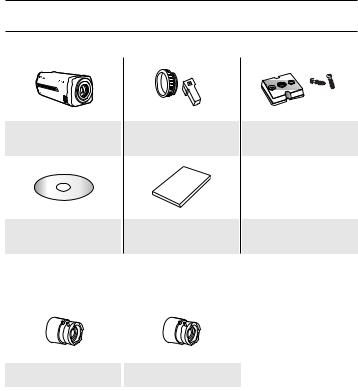
overview
What’s Included
Please check if your camera and accessories are all included in the product package.
Camera |
C Mount Adapter |
Camera Holder (Mount) |
|
Auto Iris Lens Connector |
& Screws (2EA) |
||
|
User Manual/ |
User Manual |
|
IP INSTALLER DVD |
||
|
Lens Options
CS Lens |
C Lens |
|
|
10_ overview
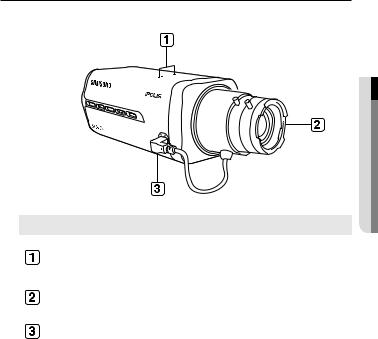
At a Glance
Front Side
v eiwove ●r
|
|
Item |
Description |
|
|
|
|
|
|
Camera Holder |
Used when you mount the camera onto the bracket by fixing the camera |
|
|
(Mount) Holes |
holder (mount) adaptor with the bracket. |
|
|
|
|
|
|
Auto Iris Lens |
Installed on the lens adaptor. |
|
|
(Optional) |
|
|
|
|
|
|
|
|
|
|
|
Auto Iris Lens |
Used to supply power and output signal to control the iris of the lens. |
|
|
Connector |
|
|
|
|
|
|
|
|
|
M |
Wipe out a dirty surface of the lens softly with a lens tissue or cloth to which you have applied |
||
ethanol. |
|
||
English _11
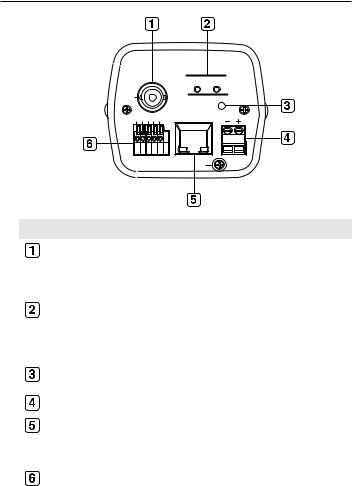
overview
Rear Side
 SYSTEM POWER
SYSTEM POWER 
VIDEO |
RESET |
1 2 3 4 5
1,2 : ALARM IN 1,2
3 : GND
4,5 : ALARM OUT 1,2
NETWORK |
|
|
ACT |
LINK |
AC 24V |
|
GND |
DC 12V |
Item |
|
Description |
|
|
|
|
|
Video Out Port |
Video signal output port connected to the monitor. |
||
|
|
|
|
|
|
ON: The camera is turned on and connected to the network |
|
|
|
properly. |
|
|
SYSTEM |
Blinking: During DDNS setup, or in case of setup failure, or |
|
System, Power |
|
in a state of unstable network connection |
|
Indicators |
|
OFF: When the system is rebooting, or turned off |
|
|
POWER |
ON: While the power is on |
|
|
OFF: If the power is off |
||
|
|
||
|
|
|
|
Reset Button |
Resets the camera settings to the default. Press and hold it for about 3 |
||
seconds to turn off the system indicator and restart the system. |
|||
|
|||
|
|
|
|
Power Port |
Used to plug the power cable. |
||
|
|
|
|
Network Port |
Used to connect to the Network cable. |
||
|
|
|
|
|
ALARM IN |
Used to connect the alarm input signal. |
|
|
1,2 |
||
|
|
||
I/O Port |
|
|
|
GND |
Used for earth-grounding. |
||
|
|
|
|
|
ALARM OUT |
Used to connect the alarm output signal. |
|
|
1,2 |
||
|
|
||
|
|
|
|
12_ overview
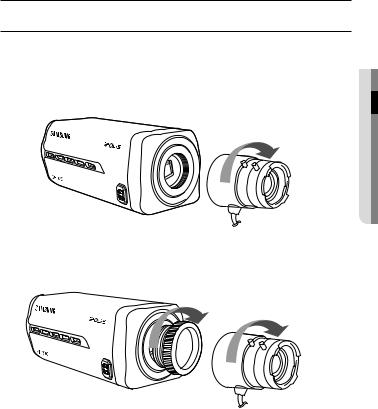
installation & connection
Mounting the lens
Disconnect the power before proceeding.
Mounting the CS lens
Turn the optional CS lens clockwise to insert it.
CS Lens
Mounting the C lens
Turn the C mount adaptor clockwise to insert it and do the same with the C lens.
C Lens
nstallatiI ● Con& nn ctie on
English _13
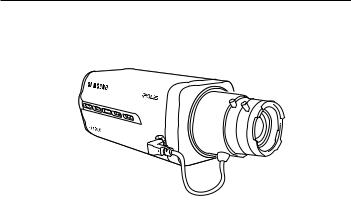
installation & connection
Connecting the Auto Iris Lens connector
Insert the lens connector into the corresponding hole of the camera.
Focusing
Turn the lens left or right to control the zoom and focus the lens so that you can view a clear, sharp object.
14_ installation & connection
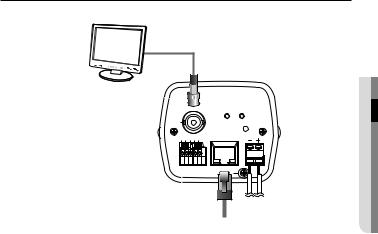
Connecting WITH OTHER DEVICE
Monitor
SYSTEM POWER
VIDEO |
RESET |
1 2 |
3 |
4 |
5 |
|
1,2 |
: ALARM IN 1,2 |
|||
3 |
: GND |
|
|
|
4,5 |
: ALARM OUT 1,2 |
|||
NETWORK |
|
ACT |
LINK |
|
GND |
AC 24V
DC 12V
Power
Network
Connecting to the monitor
Connect the [VIDEO] port of the camera to the video input port of the monitor.
Network Connection
Connect the Network cable to the local network or to the Internet.
Power Supply
Use the screwdriver to connect each line of the power cable to the corresponding port of the camera.
J |
Be careful not to reverse the polarity when you connect the power cable. |
You can also use a router featuring PoE (Power over Ethernet) to supply power to the camera. |
nstallatiI ● Con& nn ctie on
English _15

installation & connection
Connecting to the I/O port box
Connect the Alarm I/O signal to the corresponding port of the rear port box.
1 2 3 4 5
1,2 |
: ALARM IN 1,2 |
3 |
: GND |
4,5 |
: ALARM OUT 1,2 |
|
|
SYSTEM |
POWER |
|
|
|
|
|
RESET |
1 2 3 4 5 |
NETWORK |
|
|
|
: ALARM IN 1,2 |
ACT |
LINK |
AC 24V |
|
: GND |
|
GND |
|
DC 12V |
: ALARM OUT 1,2 |
|
|
||
|
|
|
|
|
ALARM IN 1, 2 : Used to connect the alarm input signal.
GND : Used for earth-grounding.
ALARM OUT 1, 2 : Used to connect the alarm output signal.
Alarm I/O Wiring Diagram
ALARM IN 1 |
1 |
ALARM IN 2 |
2 |
GND |
3 |
External Relay |
ALARM OUT 1 |
4 |
External Relay |
ALARM OUT 2 |
5 |
16_ installation & connection
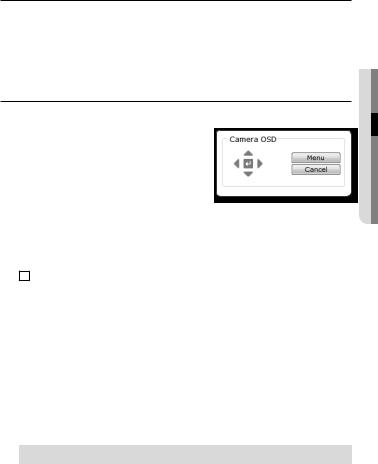
camera setup
You can configure the camera settings using the Web Viewer.
M For accessing the Web Viewer, refer to "Network Connection and Setup". (page 26)
How to use the keyboard controller
Follow the steps below if you run the Web Viewer for setting the menus.
1.Launch the Web Viewer.
2.From the [Camera OSD] menu in the left pane, click [Menu].
The <MAIN MENU> screen appears.
3.Click the Up/Down ($%) buttons to move to a desired item.
4.Click the four direction ($%_ +) buttons to navigate through the menu items.
5.To change the value of a selected item, click the Left/Right (_ +) buttons.
6.Click [  ].
].
Your changes will be applied.
 : Exits the menu setup screen.
: Exits the menu setup screen.
Before exiting the setup screen, select [SAVE] to save your settings, or [QUIT] to cancel them.
 : Saves your settings and returns to the previous screen.
: Saves your settings and returns to the previous screen.
 : Returns to the main menu.
: Returns to the main menu.
 : Use this icon if you want to save your settings after you specified the mask area and privacy area, etc.
: Use this icon if you want to save your settings after you specified the mask area and privacy area, etc.
Once you saved your settings, the changes remain intact even if you select [QUIT] on exit.
 : Use this icon if you want to delete a mask, or privacy area, etc.
: Use this icon if you want to delete a mask, or privacy area, etc.
Once you deleted your settings, the deletions remain valid even if you select [QUIT] on exit.
 : This arrow appears next to a menu that contains sub items.
: This arrow appears next to a menu that contains sub items.
For the items with the "*" mark on the right, You can get help from "Terminology". (page 60)
Cmea● raSe tu p
English _17

camera setup
MAIN MENU
You can configure the camera settings to your preference.
PROFILE
You can select a mode that is appropriate to the camera installation environment.
CAMERA SET
Configure the camera functions and settings.
PRIVACY ZONE
You can configure the privacy settings.
OTHER SET
You can configure more settings including FACTORY DEFAULTS.
SYSTEM INFO
Shows the camera version and type.
LANGUAGE
Select a preferred one from the supported languages.
**MAIN MENU **
PROFILE
CAMERA SET
 PRIVACY ZONE
PRIVACY ZONE
 OTHER SET
OTHER SET
 SYSTEM INFO
SYSTEM INFO
 LANGUAGE
LANGUAGE


PROFILE
You can select one from the pre-determined modes as appropriate to your specific camera installation environment.
Your selection on each item in PROFILE will affect all other settings of the camera. For the setting, refer to "PROFILE". (page 59)
For selecting and saving each menu item, refer to "How to use the keyboard controller". (page 17)
STANDARD
Automatically optimizes the camera settings to the normal environment.
ITS
This setting enables you to analyze the traffic situation and take the traffic information at a glance.
BACKLIGHT
This setting enables you to view a sharp background and objects even in a severe backlight scene.
◄ PROFILE ►
*STANDARD
ITS
BACKLIGHT DAY/NIGHT GAMING CUSTOM
DAY/NIGHT
Automatically optimizes the camera settings to the day and night scene.
GAMING
This automatically configures the settings so that you can work in a stable illumination condition as indoors.
CUSTOM
Your change to any of the PROFILE settings will switch the display to CUSTOM.
18_ camera setup
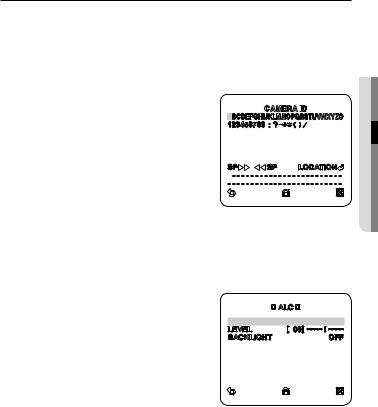
Camera Setup
You can configure the general settings of the camera module.
Use the four direction ($%_ +) buttons to select a desired item.
CAMERA ID
Provide the ID and position for a camera that displays on the screen.
For selecting and saving each menu item, refer to "How to use the keyboard controller". (page 17)
1.Select <CAMERA SET> - <CAMERA ID>.
2.Use the four direction ($%_ +) buttons to select a desired character.
In the lower input box of the screen, the selected character will be entered.
You can enter up to 54 characters including letters, numbers and special characters.
3.When done, continue to select <LOCATION> to specify the display position of the camera ID.



 CAMERA ID
CAMERA ID




ABCDEFGHIJKLMNOPQRSTUVWXYZO 123456789 :
 ?_+*()/
?_+*()/
SP►► ◄◄ SP |
LOCATION |
-- - - - - - - - - - - - - - - - - - - - - - - -
-- - - - - - - - - - - - - - - - - - - - - - - -
Cmea● raSe tu p
IRIS
You can set the iris to control the intensity of radiation entering to the camera.
For selecting and saving each menu item, refer to "How to use the keyboard controller". (page 17)
1. |
Select <CAMERA SET> - <IRIS>. |
|
|
|
2. |
Use the left/right (_ +) buttons to select either |
|
ALC |
|
|
|
|
||
|
<ALC> or <ELC>. |
LENS |
[ |
DC |
|
ALC : Controls the luminance automatically. |
LEVEL |
00] ---- I ---- |
|
|
BACKLIGHT |
|
OFF |
-LENS : Select a lens to use.
ELC : Controls the level electronically.
-LEVEL : Select an overall brightness level.
- BACKLIGHT : Specify an area to compensate for the backlight.
With <AREA> set to <USER>, you can specify the position and size.
M If the iris is set to <ALC>, fixing the iris is your priority when you adjust AE and the shutter speed.
English _19
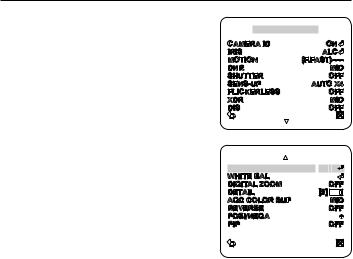
camera setup
MOTION
You can specify a level of AGC for controlling the camera motion.
Select F.FAST if you want to monitor a very fast moving object in a low contrast scene, and S.SLOW if monitoring a very slow moving, inanimate object in the same condition.
As long as DAY/NIGHT is set to AUTO, the <MOTION> menu is not available.
◄ CAMERA SET ►
CAMERA ID |
ON |
IRIS |
ALC |
MOTION |
(F.FAST)--- |
DNR |
MID |
SHUTTER |
OFF |
SENS-UP |
AUTO X4 |
FLICKERLESS |
OFF |
XDR |
MID |
DIS |
OFF |
DNR
Reduces the noise on the screen.
This is useful, especially for a noisy screen. Set it to <USER>, you can specify the level.
SHUTTER
The SHUTTER menu is used to set the fixed fast electronic shutter or auto fast electronic shutter.
DAY/NIGHT |
AUTO |
WHITE BAL |
OFF |
DIGITAL ZOOM |
|
DETAIL |
[2] |
AGC COLOR SUP |
MID |
REVERSE |
OFF |
POSI/NEGA |
+ |
PIP |
OFF |
SENS-UP
If the brightness of the video signal is too low, the Slow Shutter function will be activated. Slow Shutter can collect the individual max frame rate to adjust the setting.
FLICKERLESS
If set to <ON>, the shutter speed will be fixed to 1/100 second. This will prevent possible screen distortion due to a mismatch between the vertical sync frequency and the blinking frequency of the lighting.
If IRIS is set to ELC / SHUTTER to AUTO, FIX, EXT mode / SENSE UP to FIX / AGC to FIX, the <DIS> menu will be disabled.
XDR
This will correct a brightness difference between different scenes for the optimal visibility. The higher the value is, the higher the correction level is.
DIS
Automatically compensates for the flicker on the screen.
If set to <ON>, the image will be enlarged with digital zoom as much area as compensated.
20_ camera setup
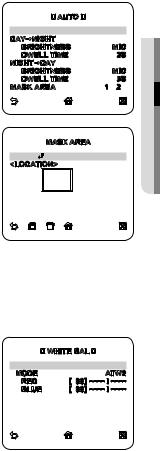
DAY/NIGHT
You can specify a recording mode according to the scene.
For selecting and saving each menu item, refer to "How to use the keyboard controller". (page 17)
1.Select <CAMERA SET> - <DAY/NIGHT>.
2.Select a screen transition mode according to the illumination, and set options as appropriate.
DAY : Fixed to DAY mode, regardless of the scene.
NIGHT : Fixed to NIGHT mode, regardless of the scene.
If BURST is set to <ON>, the burst signal will output.
AUTO : According to the luminance, this will switch DAY to NIGHT mode, or vice versa.
DAYNIGHT / NIGHTDAY : If set to <AUTO>, you can specify the brightness level triggering the mode switch between DAY and NIGHT as well as the interval.
MASK AREA : If there exists a bright spot light source in a night scene, you can specify the size and position as needed.
Any excessively bright area in a night scene will be masked.
AUTO |
|
BURST |
OFF |
DAYNIGHT |
MID |
BRIGHTNESS |
|
DWELL TIME |
2S |
NIGHTDAY |
MID |
BRIGHTNESS |
|
DWELL TIME |
5S |
MASK AREA |
1 2 |



 MASK AREA
MASK AREA 



<SIZE> 
<LOCATION> 
Cmea● raSe tu p
WHITE BAL
If you need to adjust the screen brightness, use the WHITE BALANCE function.
For selecting and saving each menu item, refer to "How to use the keyboard controller". (page 17)
1.Select <CAMERA SET> - <WHITE BAL>.
2.Select a mode where you set the balance.
DAY : You can set the RED, and BLUE value in DAY mode.
NIGHT : You can adjust the <WHITE BAL> according to the ambient luminance.
|
WHITE BAL |
|
|
DAY/NIGHT |
|
DAY |
|
MODE |
[ |
00] |
ATW2 |
RED |
I ---- |
||
BLUE |
[ |
00] ---- |
I ---- |
English _21
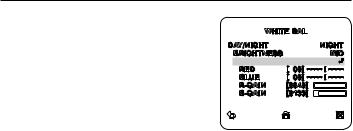
camera setup
3.According to the specified recording mode, select a WHITE BAL mode with necessary options.
BRIGHTNESS : Specify a brightness level triggering the switch from DAY to NIGHT mode.
MODE : According to the selected mode, you can adjust the RED and BLUE color level.
-RED : Adjust the strength of the red color.
-BLUE : Adjust the strength of the blue color.



 WHITE
WHITE BAL
BAL




DAY/NIGHT |
|
NIGHT |
BRIGHTNESS |
|
MID |
MODE |
[ |
AWC |
RED |
00] ---- I ---- |
|
BLUE |
[ |
00] ---- I ---- |
R-GAIN |
[0040] |
|
B-GAIN |
[0133] |
|
-R-GAIN/B-GAIN : Specify the current color temperature manually.
You can set the R-GAIN, and B-GAIN value only in AWC mode.
DIGITAL ZOOM
You can set the digital zoom factor and position.
When the zoom factor and position are defined, the digital zoom function will operate.
If you set the digital zoom to a larger factor than the actual enlargement for compensation, the DIS function will be disabled.
DETAIL
You can adjust the vertical and horizontal sharpness, respectively.
AGC COLOR SUP
This will adjust the color scheme according to the AGC value.
REVERSE
This will reverse the signal left to right, top to bottom, or a combination of the preceding.
POSI/NEGA
This will display the video brightness signal either normally or reversely.
PIP
You can view a main image with a sub image on the same screen.
22_ camera setup
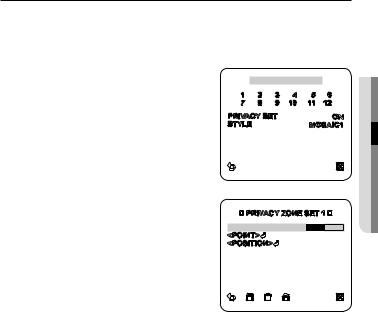
PRIVACY ZONE
You can set up to 12 privacy zones that will be hided for privacy of the subject when recording.
For selecting and saving each menu item, refer to "How to use the keyboard controller". (page 17)
Zone Setup
1. |
Select <MAIN MENU> - <PRIVACY ZONE>. |
|
◄ PRIVACY ZONE ► |
|
||||
2. |
Use the four direction ($%_ +) buttons to |
|
|
|||||
1 |
2 |
3 |
4 |
5 |
6 |
|||
|
select a desired number. |
|||||||
|
The Zone setup screen appears. |
7 |
8 |
9 |
10 |
11 |
12 |
|
|
PRIVACY SET |
|
|
ON |
||||
|
|
|
|
|||||
|
|
STYLE |
|
|
MOSAIC1 |
|||
3. |
Select the <PIXEL LEVEL>. |
|
|
|
Specify the pixel unit level for the POSITION |
PRIVACY ZONE SET 1 |
|
|
setting. |
PIXEL LEVEL |
[4] |
4. |
Select <POINT>. |
<POINT> |
|
<POSITION> |
|
||
You will see dots on the screen.
5.Use the four direction ($%_ +) buttons to specify the position for each of the four dots.
6. Select <POSITION> and use the four direction ($%_ +) buttons to specify the position for each of the four dots.
7.Save the changes and move to the previous screen and select the <STYLE>. Select <COLOR> and pick a desired color.
M Setting one or more privacy zone and enabling privacy function will disable the PIP function.
Cmea● raSe tu p
English _23
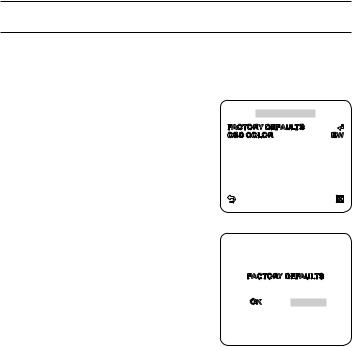
camera setup
Others
You can reset the camera, or select the OSD font color to your preference.
For selecting and saving each menu item, refer to "How to use the keyboard controller". (page 17)
Factory Default
1.Select <MAIN MENU> - <OTHER SET> - <FACTORY DEFAULTS>.
The FACTORY DEFAULTS setup screen appears.
2.Select <OK>.
All the settings will be restored to the factory default.
However, the language setting will not be restored.
◄ OTHER SET ► |
|
FACTORY DEFAULTS |
BW |
OSD COLOR |


 FACTORY DEFAULTS
FACTORY DEFAULTS 
OK CANCEL
OSD COLOR
You can set the font color of the user interface.
24_ camera setup
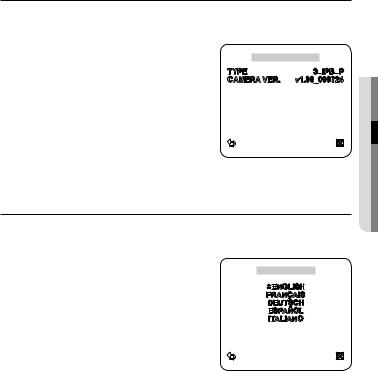
SYSTEM INFO
You can check the system information.
For selecting and saving each menu item, refer to "How to use the keyboard controller". (page 17)
1.Select <MAIN MENU> - <SYSTEM INFO>.
2.The current system information is displayed.
M |
The camera type may different, depend on the video |
signal. |
◄ SYSTEM INFO ►
TYPE |
3_IPB_P |
CAMERA VER. |
v1.00_090724 |
Language
You can select a language to your preference.
For selecting and saving each menu item, refer to "How to use the keyboard controller". (page 17)
1.Select <MAIN MENU> - <LANGUAGE>.
2.Select your preferred language using the up/down (▲▼) buttons.
M Supported language may different.
◄ LANGUAGE ►
*ENGLISH

FRANÇAIS DEUTSCH ESPAÑOL
 ITALIANO
ITALIANO
Cmea● raSe tu p
English _25
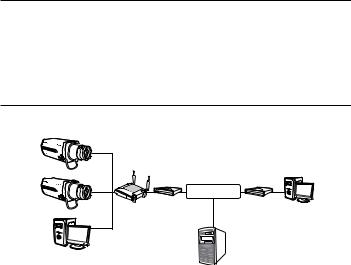
network connection and setup
You can set up the network settings according to your network configurations.
M |
Before installing or while using this program, visit the Samsung website www.samsungsecurity.com |
and download and upgrade with the latest S/W version available. |
CONNECTING THE CAMERA TO AN IP ROUTER WITH THE XDSL/CABLE MODEM
This is for a small network environment such as homes, SOHO and ordinary shops.
SNB-2000 |
|
|
|
|
|
INTERNET |
|
IPIP Router |
xDSLor |
xDSLxDSL or |
External RemotePC PC |
Cable |
Cable |
||
SNB-2000 |
Cable Modem |
Cable Modem |
|
Local PCC |
|
|
|
|
|
DDNS Server |
|
|
|
|
|
|
|
(Data Center, KOREA) |
|
|
|
(Data Center, KOREA) |
|
Configuring the network settings of the local PC connected to an IP router
Configuring the network settings of the local PC connected to an IP router, follow the instructions below.
Select : <Network Neighborhood> <Properties> <Local Area Connection> <Properties> <General> <Internet Protocol (TCP/IP)> <Properties> <Obtain an IP address automatically> or <Use the following IP address>.
Follow the instructions below if you select <Use the following IP address>:
ex1) If the address (LAN IP) of the IP router is 192.168.1.1 IP address: 192.168.1.100
Subnet Mask: 255.255.255.0 Default Gateway: 192.168.1.1
ex2) If the address (LAN IP) of the IP router is 192.168.0.1 IP address: 192.168.0.100
Subnet Mask: 255.255.255.0 Default Gateway: 192.168.0.1
26_ network connection and setup
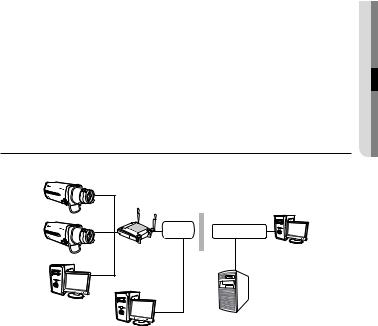
ex3) If the address (LAN IP) of the IP router is 192.168.xxx.1 IP address: 192.168.xxx.100
Subnet Mask: 255.255.255.0 Default Gateway: 192.168.xxx.1
M For the address of the IP router, refer to the product’s documentation.
Checking if the IP router is connected to the xDSL/Cable modem properly
Select <Status> from the Settings menu of the IP Router
If it is properly connected, <IP Address>, <Subnet Mask> and <Gateway> provided by your ISP are displayed. Please remember these values because they are required so that an external remote computer of the IP router connects to the camera. However, note that certain ISPs change the settings of <IP Address>, <Subnet Mask> and <Gateway> on a regular basis
If the IP router is not properly connected, press the [Connect] button to try to reconnect or check if the settings of the IP router are correct.
CONNECTING THE CAMERA TO AN IP ROUTER WITH LOCAL AREA NETWORKING
This is for a large network environment such as corporate office, building, public office and factory.
Netw● Cork nn ctie onanSe d tu p
SNB-2000
Switch
HUB 
 INTERNET
INTERNET
IPIPRouter |
External RemotePCPC |
SNB-2000 |
Firewall |
Local PCPC
DDNSServer
(DataCenter,r, KOREA)
Local PCC
Configuring the network settings of the local PC connected to an IP router
Configuring the network settings of the local PC connected to an IP router, follow the instructions below.
Select : <Network Neighborhood> <Properties> <Local Area Connection> <Properties> <General> <Internet Protocol (TCP/IP)> <Properties> <Obtain an IP address automatically> or <Use the following IP address>.
English _27
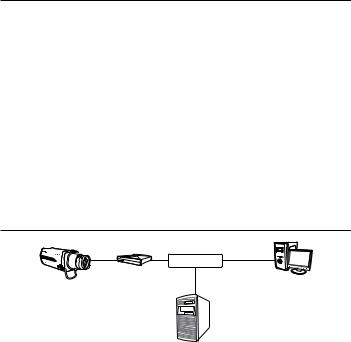
network connection and setup
Follow the instructions below if you select <Use the following IP address>:
ex1) If the address (LAN IP) of the IP router is 192.168.1.1 IP address: 192.168.1.100
Subnet Mask: 255.255.255.0 Default Gateway: 192.168.1.1
ex2) If the address (LAN IP) of the IP router is 192.168.0.1 IP address: 192.168.0.100
Subnet Mask: 255.255.255.0 Default Gateway: 192.168.0.1
ex3) If the address (LAN IP) of the IP router is 192.168.xxx.1 IP address: 192.168.xxx.100
Subnet Mask: 255.255.255.0 Default Gateway: 192.168.xxx.1
M For the address of the IP router, refer to the product’s documentation.
CONNECTING THE CAMERA DIRECTLY TO A DHCPBASED XDSL/CABLE MODEM
|
INTERNET |
xDSL or |
|
Cable |
External RemotePC PC |
Cable Modem |
|
SNB-2000 |
|
DDNSServer
(Data Center, KOREA)
(Data Center, KOREA)
Setting the IP Router
This is enabled for a modem using DHCP.
1.Set the Static or Dynamic IP address. (pages 31~36)
2.Launch an Internet browser on the local PC connected to the IP Router.
3.Enter the IP Router’s address in the address bar of the browser. ex) http://192.168.1.1, http://192.168.0.1
or http://192.168.xxx.1
For the DDNS URL address, refer to "To check the DDNS address". (page 38)
28_ network connection and setup
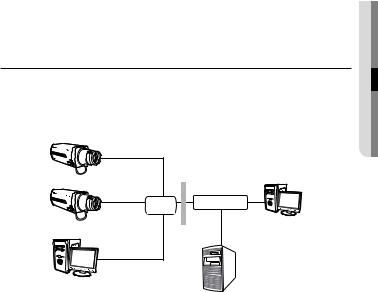
|
|
p |
|
4. |
When the IP Router is connected, the login window appears and prompts you to |
tu |
|
d |
|||
|
enter the password. |
||
|
onanSe |
||
|
For the login IP and the password, refer to the IP router’s documentation. |
||
5. |
When done, you will see the setup window of the IP router. In the setup menu, select |
ctie |
|
|
“Automatic Configuration-DHCP” for Internet Connection Type. |
nn |
|
|
For the menu location of Internet Connection Type or DHCP selection, refer to the IP router’s |
k |
|
|
documentation. |
Cor |
|
6. |
When done, click the [Save] or [Apply] button to save the settings. |
Netw● |
|
|
CONNECTING THE CAMERA DIRECTLY TO LOCAL AREA NETWORKING
Connecting to the camera from a local PC in the LAN
1.Launch an Internet browser on the local PC.
2.Enter the IP address of the camera in the address bar of the browser.
|
SNB-2000 |
|
|
Switch |
INTERNET |
|
HUB |
|
|
SNB-2000 |
External RemotePC PC |
|
Firewall |
|
|
|
|
|
LocalPPC |
DDNSServer |
|
|
(DataCenter,KOREA)) |
M |
A remote PC in an external Internet out of the LAN network may not be able to connect to the |
|
camera installed in the intranet if the port-forwarding is not properly set or a firewall is set. |
||
In this case, to resolve the problem, contact your network administrator.
English _29
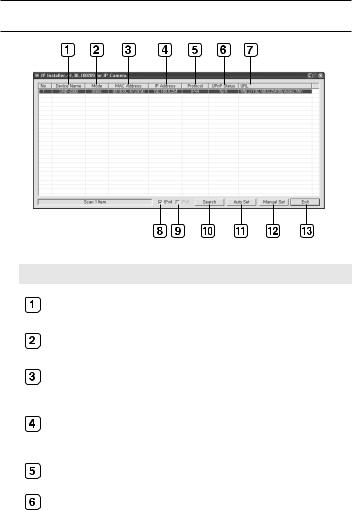
network connection and setup
IP Address Setup
Buttons used in IP Installer
Item |
Description |
|
|
|
|
|
Model name of the connected camera. |
|
Device Name |
Click the column to sort the list by model name. |
|
|
However, search will be stopped if clicked during the search. |
|
|
|
|
Mode |
Displays either <Static> or <Dynamic> for the current network connection |
|
status. |
||
|
||
|
|
|
MAC(Ethernet) |
Ethernet address for the connected camera. |
|
Click the column to sort the list by Ethernet address. |
||
Address |
||
However, search will be stopped if clicked during the search. |
||
|
||
|
|
|
|
IP address. |
|
IP Address |
Click the column to sort the list by IP address. |
|
However, search will be stopped if clicked during the search. |
||
|
||
|
The factory default is "192.168.1.200". |
|
|
|
|
|
Network setting for the camera. |
|
Protocol |
The factory default is "IPv4". |
|
|
Cameras with the IPv6 setting will be displayed "IPv6". |
|
|
|
|
UPnP Status |
This function is not currently implemented. |
|
|
|
30_ network connection and setup
